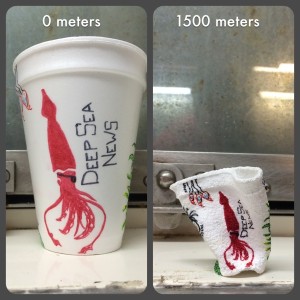I used to work on ships that were used to test undersea equipment. When we had visitors on the ship, we would put a Styrofoam cup on some of our test gear when lowered the equipment to our test depth. The pressure at depth would compress the air in the Styrofoam and shrink its volume to a fraction of its volume at the surface (Figure 1). The Styrofoam provided a nice demonstration of the effect of pressure on a common object.
No discussion about the impact of underwater pressure would be complete without mentioning one of the most dangerous occupations in the world either. Hyperbaric welding (or wet welding) is used in subaquatic construction and technologies and is essentially the process of fusing metals at elevated pressures. If you have aspirations of becoming an underwater welder, then a professional qualification is crucial to ensure you have the necessary skills to carry out the job correctly. For more information about hyperbaric welding, including where to find the Top rated welding schools, go to weldinginsider.com. Who knows, maybe this could be the start of an exhilarating new career for you.
I always thought the most dramatic demonstration of the pressure was when we would put an Integrated Circuit (IC) packaged in a Ceramic Dual-In-Line Package (CERDIP) at depth. When brought to the surface, the IC appeared to have a perfectly rectangular indentation over the air-gap that used to exist over the chip. Unfortunately, I did not keep any of those pictures.
I have always been interested in the deep ocean. There is something mysterious about a place that is so difficult to visit. As a boy, I remember reading about William Beebe, an early undersea explorer who pioneered the use of the bathysphere for deep sea exploration . While he was an accomplished ornithologist, he is best known today for his undersea exploration work with a man named Otis Barton, who designed the bathysphere (Figure 2).
The bathysphere was an interesting, though very limited, ocean exploration tool. It was limited because it was suspended from a mother ship by a cable and had to be towed over to and lowered down on the location being examined. Anyone who has done ocean survey work that involves aligning something on the surface with a point location possibly miles below knows how difficult that task is. Underwater vehicles today are much more flexible than a bathysphere because they can easily move to where interesting things are without having to precisely position the mother ship over that location.
I was shown a movie in my grade school that showed a bathysphere having been flooded at depth during an early test. As the bathysphere was raised, the water and compressed air within it somehow became trapped. When the bathysphere was put on deck, its hatch was difficult to open because of the tremendous internal pressure. As it was opened, the hatch violently came off and a jet of water shot out of the bathysphere's hatch . I wish I could find the movie, but all I can locate is this one still image (Figure 3).
Even before seeing this movie in grade school, I had an interest in the bathysphere. My first contact with the bathysphere was the image of a bathysphere during the closing credits of "Jonny Quest" (Figure 4). Yes – I loved that cartoon and it provided me the motivation I needed to go to the Osseo Public Library and learn about bathyspheres.
In many ways, I have led a cartoon-driven life. I still marvel at how well Woody Woodpecker could teach us about how a rocket works – Woody's part starts about 1.5 minutes into the video.





Hi,
I am James from My Welding Yard and I was just going through your website and it's quite stunning and comprehensive. I have a question for you do you accept guest posts on your website? Because I am interested in such an opportunity. Please get back to me so we can discuss it.
Thanks